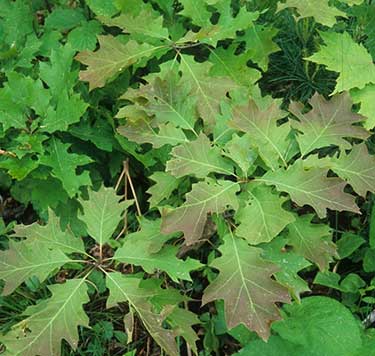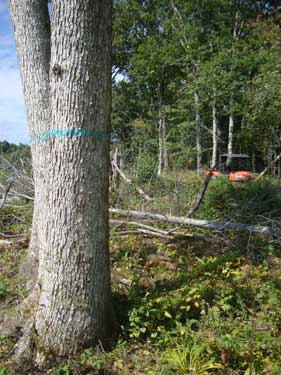Harvest Methods
Which harvest methods benefit oak?
Trees have different light requirements. You may have noticed aspen trees on the edges of fields; they exist there because they need full sun to start growing. Many species are just the opposite, preferring dense shade. Sugar maple, red maple, basswood, hemlock, and white pine seedlings grow best under a canopy of mature trees.

Oaks, hickories, ashes, and elms fall in the middle. They can tolerate some shade, but still need quite a bit of light to get established. In other words, they do not do well in dense woods.
In the case of oaks, seedlings are more tolerant of shade than are saplings and maturing trees. Selecting a harvest method that allows more light to reach the ground can help new oak trees be successful.
Harvest methods that let in light
Providing oak seedlings and saplings with the light they need to thrive requires harvest methods that uniformly increase the amount of light reaching the ground. The most predictable methods for achieving this are the small-scale clearcut, the seed-tree harvest, and the shelterwood harvest.
Small-scale clearcut
A small-scale clearcut will remove most or all woody vegetation greater than two inches in diameter in a given area. However, this doesn’t mean that all the trees on your land must be cut down. A clearcut of just two to three acres may let in enough light to allow oak seedlings and saplings to grow successfully.

Oak trees then regenerate from stump sprouts, direct seeding, or replanting. Stump sprouts are new growth that emerges from the stump of a cut tree. Older trees don’t produce stump sprouts as dependably as younger trees do; that is, this method will work better with 75-year-old trees than with 125-year-old trees.
Seed-tree harvest
A seed-tree harvest is similar to a clearcut except that some seed-producing trees are left standing in the cut area. Typically, three to 10 seed-producing trees are left per acre, and their seed will produce the next generation of trees.
In the case of oaks, the seed-producing (i.e., acorn-producing) trees that are left will not cast enough shade to prevent new oaks from growing.
Shelterwood harvest
Let’s imagine that you have big oak trees with smaller maple and basswood growing underneath. If you remove the big oaks, maple and basswood will become the next big trees and the oak component of your woods will be lost. If you want to harvest some of the big oak, but encourage new oak to come in, a shelterwood harvest may help you.
The shelterwood method selectively removes some big trees and most or all of the smaller maple and basswood, making room for regenerating oak. That is, selective harvest of some big trees creates enough openings in the canopy for oak seedling to get the light they need to establish and grow.
A second selective harvest may be employed to capture the remaining value of the oak that was left standing. Or the trees can be left to enhance the beauty and “uneven age” look of the woods.
However, since oak seedlings tolerate more shade than do oak saplings, a selective removal of most of the big oaks may be necessary 10 to 15 years after the first harvest for the next generation of oaks to grow to maturity.
